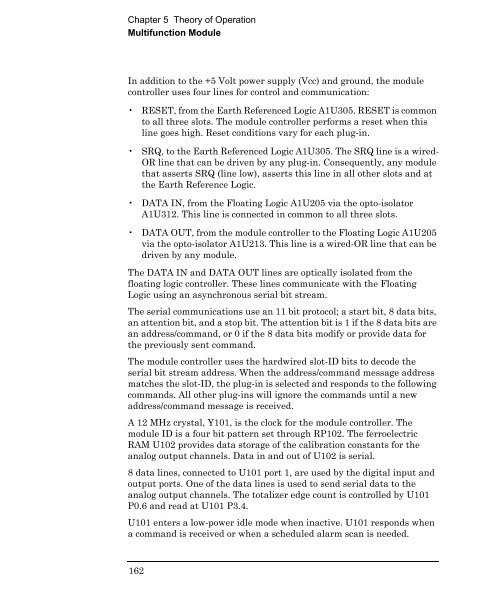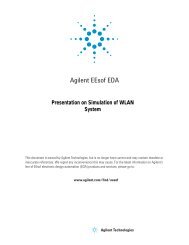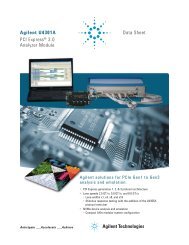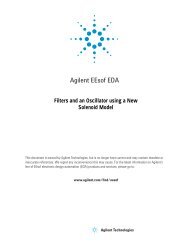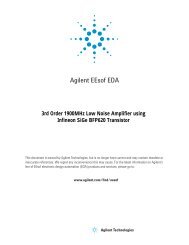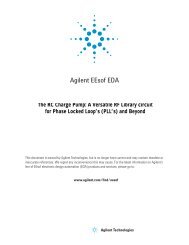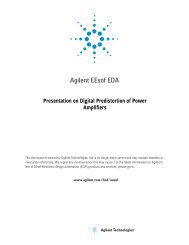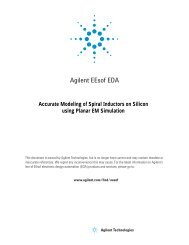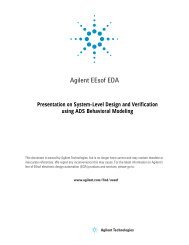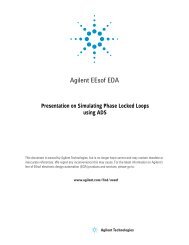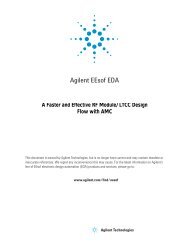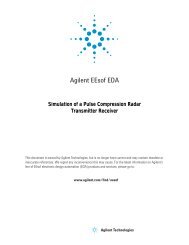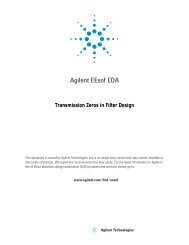Agilent 34970A/34972A Data Acquisition / Switch Unit
Agilent 34970A/34972A Data Acquisition / Switch Unit
Agilent 34970A/34972A Data Acquisition / Switch Unit
You also want an ePaper? Increase the reach of your titles
YUMPU automatically turns print PDFs into web optimized ePapers that Google loves.
Chapter 5 Theory of Operation<br />
Multifunction Module<br />
In addition to the +5 Volt power supply (Vcc) and ground, the module<br />
controller uses four lines for control and communication:<br />
• RESET, from the Earth Referenced Logic A1U305. RESET is common<br />
to all three slots. The module controller performs a reset when this<br />
line goes high. Reset conditions vary for each plug-in.<br />
• SRQ, to the Earth Referenced Logic A1U305. The SRQ line is a wired-<br />
OR line that can be driven by any plug-in. Consequently, any module<br />
that asserts SRQ (line low), asserts this line in all other slots and at<br />
the Earth Reference Logic.<br />
• DATA IN, from the Floating Logic A1U205 via the opto-isolator<br />
A1U312. This line is connected in common to all three slots.<br />
• DATA OUT, from the module controller to the Floating Logic A1U205<br />
via the opto-isolator A1U213. This line is a wired-OR line that can be<br />
driven by any module.<br />
The DATA IN and DATA OUT lines are optically isolated from the<br />
floating logic controller. These lines communicate with the Floating<br />
Logic using an asynchronous serial bit stream.<br />
The serial communications use an 11 bit protocol; a start bit, 8 data bits,<br />
an attention bit, and a stop bit. The attention bit is 1 if the 8 data bits are<br />
an address/command, or 0 if the 8 data bits modify or provide data for<br />
the previously sent command.<br />
The module controller uses the hardwired slot-ID bits to decode the<br />
serial bit stream address. When the address/command message address<br />
matches the slot-ID, the plug-in is selected and responds to the following<br />
commands. All other plug-ins will ignore the commands until a new<br />
address/command message is received.<br />
A 12 MHz crystal, Y101, is the clock for the module controller. The<br />
module ID is a four bit pattern set through RP102. The ferroelectric<br />
RAM U102 provides data storage of the calibration constants for the<br />
analog output channels. <strong>Data</strong> in and out of U102 is serial.<br />
8 data lines, connected to U101 port 1, are used by the digital input and<br />
output ports. One of the data lines is used to send serial data to the<br />
analog output channels. The totalizer edge count is controlled by U101<br />
P0.6 and read at U101 P3.4.<br />
U101 enters a low-power idle mode when inactive. U101 responds when<br />
a command is received or when a scheduled alarm scan is needed.<br />
162


